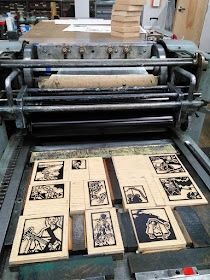We were ecstatic. The two of us! We bought a home, and immediately began nesting, cooking warm hearty meals together, planting a vegetable garden, luxuriating on Sundays in bed with the sun streaming through the upstairs windows.
One month later, I felt....odd. Not sick exactly but off. Lo and behold, and at an age one easily believes as "out of range" for such possibilities, we discovered to our complete surprise, that we were pregnant. A baby!
Our precious Takumi was born on August 6, 2015 in Oakland and our lives have been utterly transformed, and so has my art and art practice. As many of you know, I try to produce a linoleum block/letterpress calendar every year, and though its always a push for me to get it out in time for holiday sales, this year I had completely written the possibility off of the table. Being a new mom of a three month old, I was still favoring sleep over creative time.
But then one sleepless night, I started researching Japanese snow monkeys (native to Northern Japan, the Japanese Macaque), thickly furred beasts who love to luxuriate in mountainside hot springs, and fell in love again with the social bonds that these magnificent mammals share. I had to do a block print.
It took nearly two weeks to complete the drawing and do the carving, which was especially challenging given my very very limited schedule to work (I spent all night and day with Takumi during the weekdays, and get breaks in parenting with the support of my most excellent husband late nights and on the weekends), plus I've been suffering from debilitating carpal tunnel syndrome since the baby was born.
  |
| The
key block was drawn and carved in Oakland, before we headed up to the
Sierra Nevadas, and I finished the second color block, coincidentally,
in the snowy climes of Reno. |
 |
Pink monkeys for an especially tender beginning for 2016. I actually chose the color with the Japanese sweet potato (its skin is a very vibrant mauve) in mind, and likely a favorite food of the monkey. |
The calendars are available at my Etsy store for $25.00 each plus shipping. My humblest thanks to Mary Risala Laird for lending me her boxcar base, to Katherine Case, for the use of her calendar plates, Coriander Reisbord for use of the Sp20 letter press, and Samuel Arbizo for doing double daddy duty two Saturdays in a row so mama could run off into the studio. You guys are everything.



































